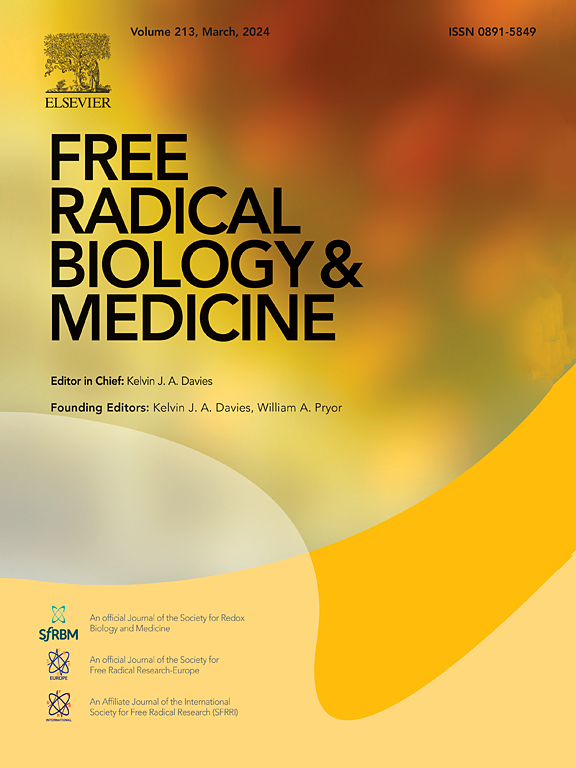Cuproptosis, a potential target for the therapy of diabetic critical limb ischemia
IF 7.1
2区 生物学
Q1 BIOCHEMISTRY & MOLECULAR BIOLOGY
引用次数: 0
Abstract
Diabetic patients are considered as the high risk population to develop critical limb ischemia (CLI), a peripheral vascular disease (PVD) resulted from atherosclerosis. Cuproptosis is a novel copper-dependent cell death that has shown the regulatory role in diabetes, while its effect on diabetic CLI has not been explored yet. In this study, Diabetic CLI mice was induced by femoral artery ligation (FAL) on diabetic mice. Endothelial injury in diabetic CLI was mimicked in human microvascular endothelial cells (HMEC-1) via the induction with high glucose (HG) and nutrient deprivation (ND). Besides, copper chelator Ammonium Tetrathiomolybdate (TM), which has shown the anti-cuproptosis property, was administrated to explore its potential effects on diabetic CLI mice and HG/ND-induced HMEC-1 cells. Strikingly, obvious cuproptosis was found in the gastrocnemius muscles of diabetic CLI mice and HG/ND-induced HMEC-1 cells, as evidenced by the copper overload and dysregulated cuproptosis-related proteins (such as Fe-S cluster proteins, copper exporter ATP7A, and copper importer SLC31A1). More importantly, TM protected against the hindlimb ischemic damages in diabetic CLI mice and alleviated cuproptosis-associated cell deaths in HG/ND-induced HMEC-1 cells. In summary, this study indicates the involvements of cuproptosis in diabetic CLI, and provides novel insights into copper chelator TM on diabetic CLI therapy.

糖尿病危重肢体缺血治疗的潜在靶点
重度肢体缺血是动脉粥样硬化引起的外周血管疾病,糖尿病患者被认为是发生该疾病的高危人群。cuprotosis是一种新的铜依赖性细胞死亡,在糖尿病中显示出调节作用,但其对糖尿病CLI的影响尚未被探索。本研究采用股动脉结扎法(FAL)诱导糖尿病小鼠CLI。通过高糖(HG)和营养剥夺(ND)诱导人微血管内皮细胞(HMEC-1)模拟糖尿病性CLI的内皮损伤。此外,我们还给药铜螯合剂四硫钼酸铵(TM),研究其对糖尿病CLI小鼠和HG/ nd诱导的HMEC-1细胞的潜在影响。引人注目的是,在糖尿病CLI小鼠的腓肠肌和HG/ nd诱导的HMEC-1细胞中发现了明显的铜变形,这可以通过铜过载和铜变形相关蛋白(如Fe-S聚集蛋白、铜输出蛋白ATP7A和铜输入蛋白SLC31A1)的失调来证明。更重要的是,TM可以保护糖尿病小鼠的后肢缺血性损伤,减轻HG/ nd诱导的HMEC-1细胞的铜中毒相关细胞死亡。综上所述,本研究表明了铜沉降在糖尿病性CLI中的作用,并为铜螯合剂TM在糖尿病性CLI治疗中的应用提供了新的见解。
本文章由计算机程序翻译,如有差异,请以英文原文为准。
求助全文
约1分钟内获得全文
求助全文
来源期刊

Free Radical Biology and Medicine
医学-内分泌学与代谢
CiteScore
14.00
自引率
4.10%
发文量
850
审稿时长
22 days
期刊介绍:
Free Radical Biology and Medicine is a leading journal in the field of redox biology, which is the study of the role of reactive oxygen species (ROS) and other oxidizing agents in biological systems. The journal serves as a premier forum for publishing innovative and groundbreaking research that explores the redox biology of health and disease, covering a wide range of topics and disciplines. Free Radical Biology and Medicine also commissions Special Issues that highlight recent advances in both basic and clinical research, with a particular emphasis on the mechanisms underlying altered metabolism and redox signaling. These Special Issues aim to provide a focused platform for the latest research in the field, fostering collaboration and knowledge exchange among researchers and clinicians.
 求助内容:
求助内容: 应助结果提醒方式:
应助结果提醒方式:


